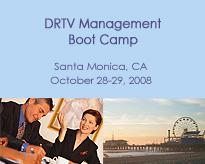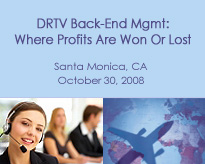| DRA Newsroom - Article Archives | ||



Courses Provided By
Direct Response Academy:
DRTV Management Boot Camp
DRTV Back-End Management:
Where Profits Are Won or Lost
Winning the Media Game
DR Financial Management:
From Scorekeeping to Strategy
Bringing Your Media In-House
2008/2009
Course Schedule:
October 28-29, 2008
DRTV Management Boot Camp
Santa Monica, CA
October 30, 2008
DRTV Back-End Management
Santa Monica, CA
December 3-4, 2008
DRTV Management Boot Camp
(bonus: Xtra DRTV
Media Buying Feature)
Philadelphia, PA
January 21-22, 2009
DRTV Management Boot Camp:
Customer Acquisition
Miami, FL
January 23, 2009
DRTV Back-End Management
Miami, FL
March 10-11, 2009
DRTV Management Boot Camp
Austin, TX
March 12, 2009
DRTV Back-End Management
Austin, TX
April 7-8 , 2009
Winning the Media Game
Santa Monica, CA
April 28-30, 2009
USA Marketplace
Geneva, Switzerland
Chamonix, France
Direct Response
Academy
Home
Brand Response Advertising
DR Project Management
DR Feasibility
On-Site Training
Telemarketing Training
Public DRTV Courses
DRTV Production
DR Finance
Media Optimization
DRTV Service Providers
Infomercial Marketing
Radio Direct Marketing
![]()
What We Do
Newsroom
About DRA
Contact Us
What Our Clients Say
Are you a:
• Corporate Marketer?
• Ad Agency or Exec?
• Entrepreneur?
• Inventor?
How to Measure the Results and Profitability
of Direct Response Television Advertising
______________________________________
by Greg Sarnow
Direct Response television marketing gives marketers immediate results. One day after the media airs, results are in and either a profit or a loss is made.
Understanding how to manage a DRTV media can make or break a campaign. Successful DRTV media campaigns spend between $100,000 to $20,000,000 and a savvy media manager can save between 10-20% of the total media cost!
Media Buying
General Advertising Versus DRTV
Whereas general advertising measures cost per point (CPP) or cost per thousand (CPM), reach and frequency, eyeballs and awareness, direct response measures profits. DR media is often referred to as “accountable advertising”, because every airing is tracked and profits or losses are measured.
What ends up being accountable is not the quantity or quality of the people watching or listening to a commercial but the quantity of people that actually pick up the phone and order a product or service they see in the commercial.
Because of this type of measurement, DRTV is a very dynamic media buy. On a daily basis airings are added, subtracted, re-negotiated or cancelled.
Another comparison is the kind of media outlets which are bought for DRTV.
DRTV short form commercials are one or two minutes. 90% of these media purchases are on National Cable stations. Only very rarely is a Network Buy made.
On the other side, Program Length Advertising (also known as Infomercials), air on 70% local broadcast stations and 30% National Cable.
Measuring Profitability
The main way professional Direct Response marketers calculate profit is with a Cost Per Order (CPO) model. This model accounts for the direct profits of each product sold and the media costs per order. Below are the key issues to develop the model.
Every product sold has costs associated to that sale. For example, the cost of goods sold, telemarketing, shipping & handling, fulfillment and merchant account costs are examples of these costs.
Every sale creates revenues: product sold, upsells, membership clubs and shipping and handling all add up to create total revenue.
Subtracting the expenses from the revenues gives you the gross profit of each item sold.
As an example, and for simplicity sake, let’s just say that the revenue on Dream Eyes famous Miracle Eye Creme is $ 29.00 and all of the expenses are $ 14.00. That would create a gross profit of $ 15.00 per order taken.
If we buy media from a National Cable station for $ 1000.00 and receive100 orders, our media cost per order is $ 10.00. With the sample above, our profit is $ 5.00 per order which equals a total profit of $ 500.00. Not bad on a $ 1000.00 media buy!
Each airing can then be analyzed by its profitability, and this is the basis for creating and managing a media campaign.
Testing Strategies
The next step in media buying is creating a test to find out how the creative production, product offer, and the price points impact sales. There are several factors that go into determining how much money should be spent on a test, but the goal of the test is to find out if you have a commercial that is profitable.
The strategies for DR short form and Program length advertising (long form) are quite similar, but the tactics to achieve results are radically different. Testing correctly is critical.
There are 4 IRON rules for testing.
1. Define a successful result before you start!
The diversity of direct response campaigns demands a unique understanding of your marketing goals and how to translate the media results into total return on investment. Marketing models should account for continuity programs, upsells, clubs, retail and catalogue sales.
Brand awareness is an intangible, which is difficult to give value to but will quickly be felt, especially in retail, if you are running enough media. For every product sold from a DR commercial between 5-10 are sold in retail!
2. Include enough stations to give you examples of how different types of audiences react to your product.
For example in long form you might take about 20 local broadcast stations and four or five small cable stations. In short form, you might take six or seven cable stations which target your primary demographic.
This will give you enough information at the end of the test to draw conclusions. Too little information can be disastrous in mistakenly concluding the value of the commercial being tested.
3. Choose crème de la crème media outlets.
A test is exactly what it says, A TEST. Everyone thinks they have a home run but the fact is that singles and doubles can earn excellent profits. Your media buyer should give you the very best media they have which they can prove works for the targeted demographic of your product.
If the media is profitable, you can move forward from a point of success. If the very best media doesn’t work, then you know where you stand, and you won’t have to second guess forever.
4. Analyze results thoroughly after the media test is complete.
Don’t make decisions about the success of your test until the test is completely over and all the results are in. Each airing can reveal important information and the telemarketing reports have to be compared to the media that actually aired to know the results.
Even in very successful campaigns, clues about rolling out need to be studied. Which airings were profitable which weren’t, how many people called vs. how many people ordered, percentage upsells taken and average revenue per order are all important statistics.
The purpose of a test is to accumulate enough information to know how to move forward with assurance. Accumulating this info does not take very long so let the process unfold before you move forward.
A media test usually takes between one and two weeks and the results are finalized in just a couple of days. Short form media tests usually run in the $ 10,000-$ 15,000 range and long form tests usually run between $ 10,000 – $ 30,000 range depending on the quantity of parameters being tested.
If your show tests well, a media rollout campaign begins. This is where the fun starts because for several weeks media budgets are increasing while results are analyzed to find the most profitable media expenditure. Sometimes media budgets go up $ 25-30,000 each week and sometimes they increase by $ 100,000.00 each week.
In our next article, we will live a day in the life of a DRTV media buyer after a campaign is in the middle of the rollout. Now that is insanity at its finest!!
###
The DirectResponseAcademy, founded in 1999 in Austin, Texas, is the only educational company dedicated to teaching the best practices of direct response television marketing. The DRA offers executive training, project management and consulting services for companies and individuals who are launching or managing DRTV campaigns.
